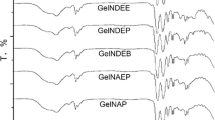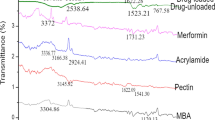Abstract
The main aim of this study was to develop a novel pH-sensitive hydrogel prepared via an UV light-induced polymerization. Single-factor experiments were performed to acquire the optimum formula of final poly(MAA-co-PEGMA) hydrogel. Fourier transform infrared spectroscopy (FTIR) spectra were employed to confirm the successful preparation of the designed copolymers. Inner morphologies of the polymeric hydrogels were observed via an S-4800 scanning electron microscope (SEM). Swelling and reversible swelling–shrinking studies were carried out in different phosphate buffer solution (PBS) with various pH values. Drug-loading tests were performed with bovine serum albumin (BSA) as a model drug. The in vitro release profile was also investigated in PBS with the pH values of 1.2 and 7.4. FTIR spectra confirmed the preparation of the poly(MAA-co-PEGMA) copolymers without any residual monomers. The typical space grid structures were observed from the SEM photographs of hydrogels. The obtained hydrogel showed an excellent pH-sensibility and reversible swelling–shrinking property. The maximum drug-loading (40.9 %) was gained from the BSA concentration of 50.0 mg/mL. During the releasing process, only 5.8 ± 0.9 % of BSA was released at pH 1.2, but 82.1 ± 6.2 % was diffused at pH 7.4. These data suggested that such medicated hydrogel could deliver BSA to alkaline conditions (e.g., intestinal environments) site-specifically, which protected BSA from destroying by gastric acid or pepsase. Therefore, such hydrogel had a significant meaning in theoretical research and practical application.








Similar content being viewed by others
References
F. Ganji, E. Vasheghani-Farahani, Hydrogels in controlled drug delivery systems. Iran. Polym. J. 18(1), 63–88 (2009)
Q. Shang, Y. Zhang, T. Chen, Y. Liang, Y. Shi, Preliminary studies on pH-sensitive hydrogels and in vitro release profiles of two model drugs. J. Biomater. Sci. Polym. Ed. 24(12), 1459–1471 (2013)
R. Marcombe, S. Cai, W. Hong, X. Zhao, Y. Lapusta, Z. Suo, A theory of constrained swelling of a pH-sensitive hydrogel. Soft Matter 6, 784–793 (2010)
S.-C. Chen, Y.-C. Wu, F.-L. Mi, Y.-H. Lin, L.-C. Yu, H.-W. Sung, A novel pH-sensitive hydrogel composed of N, O-carboxymethyl chitosan and alginate cross-linked by genipin for protein drug delivery. J. Control. Release 96, 285–300 (2004)
M. Liu, L. Wang, H. Su, H. Cao, T. Tan, pH-sensitive IPN hydrogel based on poly(aspartic acid) and poly(vinyl alcohol) for controlled release. Polym. Bull. 70(10), 2815–2827 (2013)
C. Wang, A. Javadi, M. Ghaffari, S. Gong, A pH-sensitive molecularly imprinted nanospheres/hydrogel composite as a coating for implantable biosensors. Biomaterials 31(18), 4944–4951 (2010)
V. Dulong, G. Mocanu, D.L. Cerf, A novel amphiphilic pH-sensitive hydrogel based on pullulan. Colloid Polym. Sci. 285(10), 1085–1091 (2007)
Q. Wang, X. Xie, X. Zhang, J. Zhang, A. Wang, Preparation and swelling properties of pH-sensitive composite hydrogel beads based on chitosan-g-poly(acrylic acid)/vermiculite and sodium alginate for diclofenac controlled release. Int. J. Biol. Macromol. 46(3), 356–362 (2010)
M.S. Mohy Eldin, H.M. El-Sherif, E.A. Soliman, A.A. Elzatahry, A.M. Omer, Polyacrylamide-grafted carboxymethyl cellulose: smart pH-sensitive hydrogel for protein concentration. J. Appl. Polym. Sci. 122(1), 469–479 (2011)
R. Gong, C. Li, S. Zhu, Y. Zhang, Y. Du, J. Jiang, A novel pH-sensitive hydrogel based on dual crosslinked alginate/N-α-glutaric acid chitosan for oral delivery of protein. Carbohydr. Polym. 85, 869–874 (2011)
D. Mandracchia, G. Pitarresi, F.S. Palumbo, B. Carlisi, G. Giammona, pH-sensitive hydrogel based on a novel photocross-linkable copolymer. Biomacromolecules 5(5), 1973–1982 (2004)
Y.-N. Dai, P. Lia, J.-P. Zhang, A.-Q. Wang, Q. Wei, A novel pH sensitive N-succinyl chitosan/alginate hydrogel bead for nifedipine delivery. Biopharm. Drug Dispos. 29, 173–184 (2008)
B. Hui, J. Chen, L. Yang, J. Li, Y. Pei, L. Shi, Preparation of pH- and thermo-sensitive hydrogel by two-step grafting of acrylamide and acrylic acid onto preirradiated polyethylene film. J. Radioanal. Nucl. Chem. 260(3), 673–677 (2004)
J. Sun, J. Chen, L. Yang, S. Wang, Z. Li, H. Wu, Synthesis and characterization of a pH-sensitive hydrogel made of pyruvic-acid-modified chitosan. J. Biomater. Sci. Polym. Ed. 18(1), 35–44 (2007)
L. Shi, L. Yang, J. Chen, Y. Pei, M. Chen, B. Hui, J. Li, Preparation and characterization of pH-sensitive hydrogel of chitosan/poly(acrylic acid) co-polymer. J. Biomater. Sci. Polym. Ed. 15(4), 465–474 (2004)
D. Huang, C. Zhang, K. Yu, T. Wang, J. Mu, Preparation of a novel pH-sensitive hydrogel based on acrylic acid and polyhedral oligomeric silsesquioxane for controlled drug release of theophylline. Polym. Bull. 71(8), 1877–1889 (2014)
S.J. Kim, C.K. Lee, Y.M. Lee, Electrical/pH-sensitive swelling behavior of polyelectrolyte hydro gels prepared with hyaluronic acid–poly(vinyl alcohol) interpenetrating polymer networks. React. Funct. Polym. 55(3), 291–298 (2003)
M.N. Khalid, F. Agnely, N. Yagoubi, J.L. Grossiord, G. Couarraze, Water state characterization, swelling behavior, thermal and mechanical properties of chatoyant based networks. Euro. J. Pharm. Sci. 15(5), 425–432 (2002)
E. Unsal, A. Durdu, B. Elmas, M. Tuncel, A. Tuncel, A new affinity-HPLC packing for protein separation: cibacron blue attached uniform porous poly(HEMA-co-EDM) beads. Anal. Bioanal. Chem. 383(6), 930–937 (2005)
Z. Liu, Y. Luo, K. Zhang, P(AAm-co-MAA) semi-IPN hybrid hydrogels in the presence of PANI and MWNTs-COOH: improved swelling behavior and mechanical properties. J. Biomater. Sci. Polym. Ed. 19(11), 1503–1520 (2008)
J. Wu, J. Lin, G. Li, C. Wei, Influence of the COOH and COONa groups and crosslink density of poly(acrylic acid)/montmorillonite superabsorbent composite on water absorbency. Polym. Int. 50(9), 1050–1053 (2001)
M. Morishita, A.M. Lowman, K. Takayama, T. Nagai, N.A. Peppas, Elucidation of the mechanism of incorporation of insulin in controlled release systems based on complexation polymers. J. Control. Release 81, 25–32 (2002)
W.B. Liechty, M.C. Moore, M.A. Phillips, C. Schoener, N.A. Peppas, Responsive theranostic systems: integration of diagnostic imaging agents and responsive controlled release drug delivery carriers. J. Biomed. Microdevices Release 119, 155 (2011)
Author information
Authors and Affiliations
Corresponding author
Rights and permissions
About this article
Cite this article
Tian, R.Q., Zhao, Y.G., Cui, Y.Q. et al. Preparation and characterization of a novel pH-sensitive hydrogel obtained from UV light-induced polymerization. Appl. Phys. A 119, 753–761 (2015). https://doi.org/10.1007/s00339-015-9024-4
Received:
Accepted:
Published:
Issue Date:
DOI: https://doi.org/10.1007/s00339-015-9024-4




